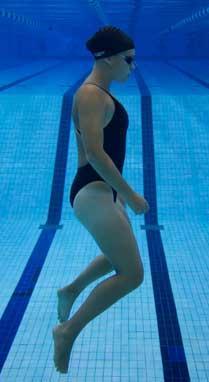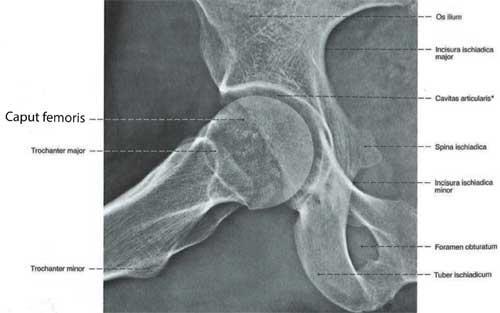
Picture: The person floating in water has safe joint angles. They are the same that can be reached by sitting on a two-part saddle chair.
In the conventional sitting position the hip and knees form a 90-90 degree angle. As a long lasting position this is most unnatural and thus harmful to the joints, as they should be straightened out more out and be more mobile. Tightness occur also in many ligaments and deep muscles in the pelvis-thigh-knee area causing easily in the long run many disorders that can reflect as pain in numerous tissues in the area.
In the knee the 90 degree angle makes patella and Tibialis tendons very tight, increasing the unnatural static pressure to the cartilage and thus speeding up the beginning of arthritis. In addition, the knees that have been passive when you were sitting are suddenly hit with a harmful pressure impulse every time you stand up from the 90 degree angle. Anyone can notice the discomfort or pain in the lower limb joints caused by long-term sitting as one stands up after a long flight or a car trip.
In the hip the upward pressure of the chair in 90 – 90 degree sitting increases pressure on the cartilage on the upper surface of the hip joint. Nowadays we sit normally 10-16 hours a day on various seats all along the day. So the pressure is on the joint all this time. Long term pressure in the cartilage prevents normal metabolism and so the tissues start to degenerate into arthritis.
Traditional sitting causes hip degeneration because there is a pressure point in the upper hip bowl (picture). The seat pushes the femur up and the body sinks down because of gravity. In riding-like sitting the seat pushes the femur out and releases the pressure on the cartilage in the hip joint. This increases circulation and improves the cartilage / joint health and prevents arthritis

Picture: A 90 degree angle puts a lot of pressure on the knee cartilage tissues when the tibialis and patella ligaments become tight. This pressure also degenerates the knee, together with other risk factors. Saddle sitting eliminates the poor 90 degree angle and extra pressure.
Original source of picture: Paulsen, Waschke, Sobotta Atlas of Human Anatomy, 15th Edition 2011©Elsevier GmbH, Urban & Fischer, Munich.
Prevention
The development of all these joint problems can largely be prevented by maintaining a sitting position in which the back is in a good posture at all times, head is held straight and hips and knees form at least a 135-135 degree angle.
The easiest way to achieve this is to use a saddle chair that has a two-part seat. That will keep the user’s pelvis in an upright position, as if they were standing, and the seat supports the weight on the sitting bones. The genitalia are well ventilated and no harmful pressure is concentrated on the area, which makes it easy to maintain the correct posture in the pelvis considering, that too tight clothes are not preventing the correct pelvic posture.
The joint-friendly working environment includes much more motion than before. Its good to stand 15 -20 min periods as you feel like it. Seat with swinging mechanism creates micro motion (sit & swing) in the lumbar–pelvic area. Place is finalized by an electronically adjustable table that has different pre-set height settings and soft elbow pads under the shoulder line. There should also be a high-quality monitor (or rather 2-3 monitors because of the efficiency of the work and the movements of the neck) situated on the right height (upper edge on the same level with the eyes). In addition, joints and muscles benefit from a working environment that has been designed so that the person needs to roll back and forth to pick up and reach (roll & reach) for items while sitting on the chair.
Getting up from the chair every now and then and walking some stairs (walk & talk) or at least some dozens of steps is also good for you. Use a hands-free Bluetooth while talking on the phone. With your hands free you can walk, stretch or even exercise with variable equipment without the call being disturbed. Definitely have a walking/exercise break once every hour at least. These movements activate the metabolism in cartilage of the joints and strengthen the muscles, reducing the risks even more.
Many special nutrients have been found to be useful in maintaining the health in the joints or even healing the problems. They are metylsulfonylmetane (MSM), vitamin D, magnesium (Mg), Omega 3 fat acids up to 3 g/day, calcium (Ca), ginger, protease enzyme, serrapeptazic enzyme, chondroitin sulfate extract, cissus herb, chodroitin sulfate and other antioxidants, because joint problems are inflammatory diseases. Also it´s useful to use shark cartilage and green-lipped mussel (Perna canaliculus)concentrates.
Mistletoe can be used as medicine for degenerated joints as well as some spices which have joint health impacts like basil, capers, chervil, savory, and bay leaf.
Avoiding obesity and carrying heavy loads are also meaningful. Magnet therapy, acupuncture (electric or conventional) and special plant based diets can have significant therapeutic impacts as well. Sleeping in beds which are not in so called “earth radiation” also known as “water vein” fields, can be crucially important.
The statements on the page are based on the following sources:
Michael Adams, Nikolai Bogduk, Kim Burton, Patricia Dolan: The Biomechanics of Back Pain
David A. Rubenstein, Wei Yin, Mary D. Frame: Biofluid Mechanics, an Introduction to Fluid Mechanics, Macrocirculation, and Microcirculation
Marcus J. Seibel, Simon P. Robins, John P. Bilezikian: Dynamics of Bone and Cartilage Metabolism, Principles and Clinical Applications
